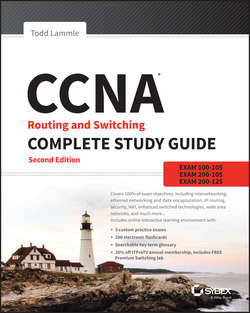Читать книгу CCNA Routing and Switching Complete Study Guide - Todd Lammle - Страница 13
На сайте Литреса книга снята с продажи.
Part 1
ICND1
Chapter 1
Internetworking
Written Labs
ОглавлениеIn this section, you’ll complete the following labs to make sure you’ve got the information and concepts contained within them fully dialed in:
Lab 1.1: OSI Questions
Lab 1.2: Defining the OSI Layers and Devices
Lab 1.3: Identifying Collision and Broadcast Domains
You can find the answers to these labs in Appendix A, “Answers to Written Labs.”
Written Lab 1.1: OSI Questions
Answer the following questions about the OSI model:
1. Which layer chooses and determines the availability of communicating partners along with the resources necessary to make the connection, coordinates partnering applications, and forms a consensus on procedures for controlling data integrity and error recovery?
2. Which layer is responsible for converting data packets from the Data Link layer into electrical signals?
3. At which layer is routing implemented, enabling connections and path selection between two end systems?
4. Which layer defines how data is formatted, presented, encoded, and converted for use on the network?
5. Which layer is responsible for creating, managing, and terminating sessions between applications?
6. Which layer ensures the trustworthy transmission of data across a physical link and is primarily concerned with physical addressing, line discipline, network topology, error notification, ordered delivery of frames, and flow control?
7. Which layer is used for reliable communication between end nodes over the network and provides mechanisms for establishing, maintaining, and terminating virtual circuits; transport-fault detection and recovery; and controlling the flow of information?
8. Which layer provides logical addressing that routers will use for path determination?
9. Which layer specifies voltage, wire speed, and cable pinouts and moves bits between devices?
10. Which layer combines bits into bytes and bytes into frames, uses MAC addressing, and provides error detection?
11. Which layer is responsible for keeping the data from different applications separate on the network?
12. Which layer is represented by frames?
13. Which layer is represented by segments?
14. Which layer is represented by packets?
15. Which layer is represented by bits?
16. Rearrange the following in order of encapsulation:
Packets
Frames
Bits
Segments
17. Which layer segments and reassembles data into a data stream?
18. Which layer provides the physical transmission of the data and handles error notification, network topology, and flow control?
19. Which layer manages logical device addressing, tracks the location of devices on the internetwork, and determines the best way to move data?
20. What is the bit length and expression form of a MAC address?
Written Lab 1.2: Defining the OSI Layers and Devices
Fill in the blanks with the appropriate layer of the OSI or hub, switch, or router device.
Written Lab 1.3: Identifying Collision and Broadcast Domains
1. In the following exhibit, identify the number of collision domains and broadcast domains in each specified device. Each device is represented by a letter:
A. Hub
B. Bridge
C. Switch
D. Router
